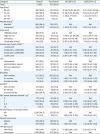2. Korea Central Cancer Registry. National Cancer Center. Annual report of cancer statistics in Korea in 2015, Ministry of Health and Welfare. Goyang: National Cancer Center;2017.
6. World Health Organization. Human papillomavirus vaccines: WHO position paper, May 2017-Recommendations. Vaccine. 2017; 35:5753–5755.

7. Korea Centers for Disease Control and Prevention. Guidelines for the National Immunization Program [Internet]. Cheongju: Korea Centers for Disease Control and Prevention;c2009. cited 2018 Aug 2. Available from:
http://nip.cdc.go.kr.
8. Schiller JT, Castellsagué X, Villa LL, Hildesheim A. An update of prophylactic human papillomavirus L1 virus-like particle vaccine clinical trial results. Vaccine. 2008; 26:Suppl 10. K53–K61.

9. Crow JM. HPV: The global burden. Nature. 2012; 488:S2–S3.

11. Korea Centers for Disease Control and Prevention. 2013 Korea National Immunization Survey. Cheongju: Korea Centers for Disease Control and Prevention;2013.
13. Lee LY, Garland SM. Human papillomavirus vaccination: the population impact. F1000 Res. 2017; 6:866.

14. Min KJ, Kwon SH, Kim S, Kim HJ, Seong SJ, Song YJ, et al. Preventive vaccination against cervical cancer: Korean Society of Gynecologic Oncology Guideline. J Gynecol Oncol. 2016; 27:e30.

16. Muñoz N, Manalastas R Jr, Pitisuttithum P, Tresukosol D, Monsonego J, Ault K, et al. Safety, immunogenicity, and efficacy of quadrivalent human papillomavirus (types 6, 11, 16, 18) recombinant vaccine in women aged 24–45 years: a randomised, double-blind trial. Lancet. 2009; 373:1949–1957.


17. Castellsagué X, Muñoz N, Pitisuttithum P, Ferris D, Monsonego J, Ault K, et al. End-of-study safety, immunogenicity, and efficacy of quadrivalent HPV (types 6, 11, 16, 18) recombinant vaccine in adult women 24–45 years of age. Br J Cancer. 2011; 105:28–37.



18. Carter JJ, Koutsky LA, Hughes JP, Lee SK, Kuypers J, Kiviat N, et al. Comparison of human papillomavirus types 16, 18, and 6 capsid antibody responses following incident infection. J Infect Dis. 2000; 181:1911–1919.


19. Lau S, Franco EL. Management of low-grade cervical lesions in young women. CMAJ. 2005; 173:771–774.

20. Powell SE, Hariri S, Steinau M, Bauer HM, Bennett NM, Bloch KC, et al. Impact of human papillomavirus (HPV) vaccination on HPV 16/18-related prevalence in precancerous cervical lesions. Vaccine. 2012; 31:109–113.









 PDF
PDF Citation
Citation Print
Print




 XML Download
XML Download